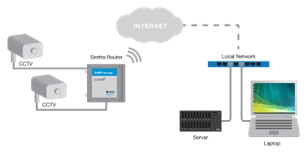Factors to consider in selecting industrial or consumer grade modems and routers
Follow articleHow do you feel about this article? Help us to provide better content for you.
Thank you! Your feedback has been received.
There was a problem submitting your feedback, please try again later.
What do you think of this article?
The primary forms of product design and construction necessary to meet the various operational, environmental, power, reliability, and serviceability needs in the market will be compared and evaluated in this article. Specifically, the variations between items of an industrial and consumer-grade.
It is important to review the essential definitions in relation to the products we are considering before looking at the constructions. The first step is a router, which establishes a network among peripheral devices by identifying network interfaces and providing location addressing. The second is a modem, which connects a network and the devices on it to the internet by transforming data into a format that can be sent securely and decoded with reliability.
What factors should be taken into account thus when deciding between an Industrial and a Consumer grade device? In both our personal and professional lives, we continue to have an insatiable appetite for connectivity and data consumption. It is simple to believe that the differences between the hardware we use at home and in our professional lives are negligible when it comes to accessing data or connecting to the outside world. This presumption is false in networking, as it is in many other fields, and there is still disagreement over the best gear.
“We have a lot of different Modem and Router options in our homes.”
According to UK government figures, more than 90% of homes have internet access, which translates to 22 million installed bases. Additionally, a 2019 Deloitte survey indicates that every home has, on average, 10 connected gadgets. Consumer-grade hardware is therefore by nature high volume and cheap cost, and Internet Service Providers (ISPs) frequently give it out for free. The majority of ISPs then opt to deploy subscription services in order to pursue a recurring revenue business model. In order to maximise revenue and profit, the provided hardware is consequently optimised to employ the least amount of functionality, associated circuit design, and software, as well as the lowest amount of manufacturing cost. This is shown when comparing products that have failed in the past (MTF).
We have all encountered poor speeds, connectivity issues, or gadget failure, which, while unpleasant, generally have little of an impact on a typical home. With a consumer-grade solution, most of our daily browsing needs are met, and it happens swiftly and safely. Even with the delivery-related downtime, it is relatively simple for the ISP to send a replacement for the customer to install themselves if the device fails.
Industrial applications —among which we also include enterprise business applications—represent a very distinct situation. Invoking Clive Humby's statement that "Data is The New Oil," every industrial and enterprise company will want to make sure that its usage of its most valuable asset, the data it generates, is protected.
Since the risk of downtime is very expensive both monetarily and in terms of reputation, the reliability of data flows and connection uptime is of major importance and is seen as essential. The application being supported, the environment where the data flow originates, and the infrastructure available should be more important considerations when choosing a device.
Consider the cost of a temporary interruption of connectivity to an enterprise, like Amazon, where you could calculate the impact in millions of pounds, euros, or dollars each hour. Similar to this, medical facilities and services want secure communications. Markets and financial institutions are constantly seeking little improvements in connection speed, where reliability and service accessibility IoT also offer advantages that can be valued in the billions of pounds, euros, or dollars.
In the aforementioned cases, dependability and speed are prerequisites. Data transmission speed is still a factor to be taken into consideration, but as we advance up the Industrial IoT inflection curve, there are many more applications where reliability, environmental tolerance, and remote device control are of a larger significance. Many gadgets need to be able to withstand severe temperatures and have minimal power requirements since they are being used in harsh and remote situations.
A cellular solution is necessary as the only available alternative because connectivity infrastructure might not exist or be generally accessible. Providing supervisory access to remote equipment in solar farms, controlling the charging of electric vehicles, monitoring the performance of remote oil pumps and drilling stations to ensure that schedules are maintained, ensuring that the production of raw materials is not interrupted due to faults and equipment breakdown, ensuring that automatic payment machines are operating, and all of these examples require solutions that enable access to remote equipment with a robust and reliable connection.
Consumer devices are made to operate in very different environments and frequently have shorter life spans, which is reflected in their price point and warranty. Industrial and enterprise applications, on the other hand, require a more robust solution because device connectivity can be affected by environmental and operating conditions.
Devices made for industrial and enterprise employ more premium components that are built to withstand hard conditions, function in a broader range of temperatures, and frequently have sophisticated power management circuitry and software. They will function in a far broader range of environmental conditions and provide corresponding longer and larger warranties. In fact, many warranties of consumer-grade products could expressly forbid usage in industrial or business applications.
In conclusion, there are a number of variances between industrial and consumer-grade equipment, and these differences will have an impact on price. As previously mentioned, devices produced for the industrial and enterprise markets will have a different and higher overall specification and associated value proposition than those produced for the consumer market alone. This is due to the number of additional features and higher quality of construct required for these markets. Consumer electronics made for the big ISPs are produced in large quantities under tight financial constraints, and they are frequently given away for free with 12- or 18-month service agreements.
Industrial Modems and Industrial Routers are enabling products that help to achieve the following:
- Lower deployment risk due to utilization of dependable industrial solutions
- Work across a diverse range of operational, geographic, and environmental contexts
- Develop and implement your application quickly to give distant equipment internet connection.
- Improve equipment responsiveness and dependability without introducing a complex system infrastructure.
- Possess a system-agnostic design that is compatible with any kind of hardware or operating system
- Automatic network detection and continual network monitoring
- Possess a range of devices that permit the use of a single footprint and form factor solution.
- The capacity to offer end equipment with every type of connectivity and upgrade
- Reduce expensive engineer callouts to achieve cost savings and efficiency gains,
- Improved estate reports that monitor heavily trafficked areas resulting in more efficient preventative maintenance.
The key deciding criteria in whether to choose consumer- or industrial-grade equipment are risk, environmental and power-related considerations. The more you need to rely on an industrial product, the more crucial it becomes to have a strong, dependable connection. Consider data's value and the value that connection reliability means to an organisation.
A variety of industrial modems, industrial routers, and managed network solutions are available from Siretta, dubbed "The Industrial IoT Company”. They provide a variety of cellular-capable modems that have been built to industrial specifications to make it simple to connect remote devices to the internet. These solutions fall under the category of industrial low and ultra-low power modems. In order to provide dependable and stable connection options that can be monitored and managed from a central place, their industrial modem and router offering enables the setup, configuration, monitoring, and management of industrial IoT networks.
Through their innovative Modem Selector Tool and Router Selector Tool, which are specifically filtered to meet your exact criteria, Siretta assists you in finding the best industrial modem and industrial router solution for your application.
Having a wealth of experience and a focus on industrial-grade cellular technologies, Siretta is a great partner and a top manufacturer and developer of IoT devices, IoT software, and IoT industrial and business-to-business applications.




